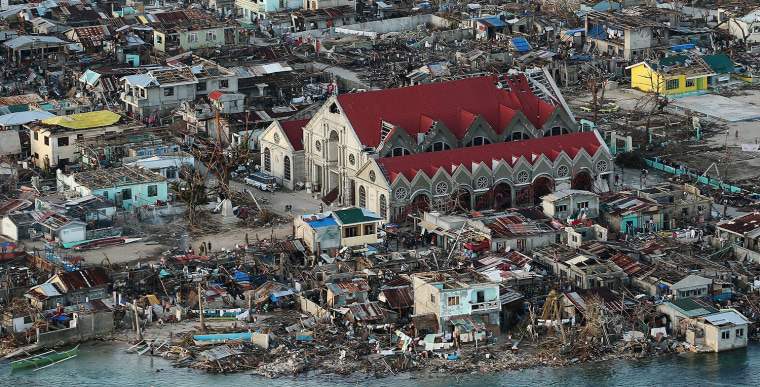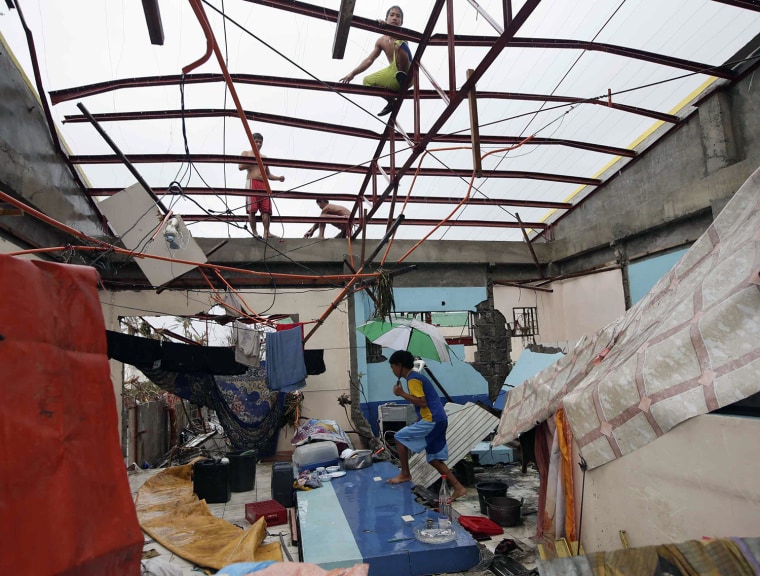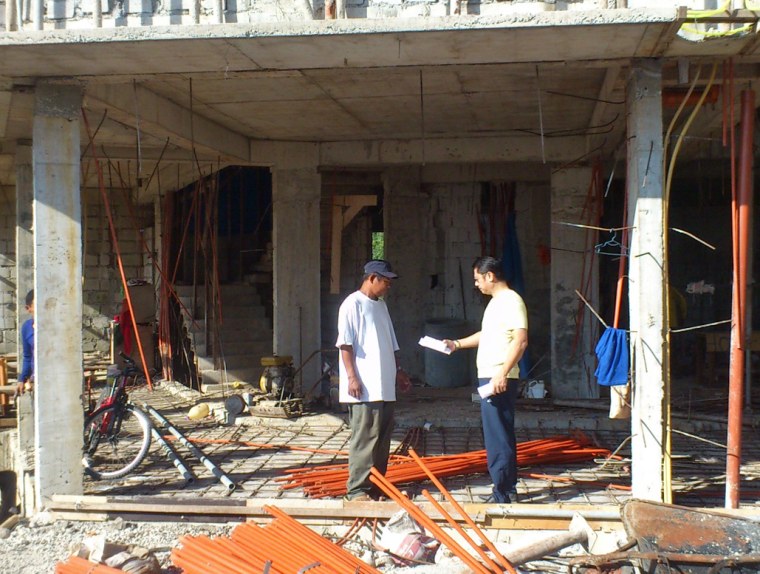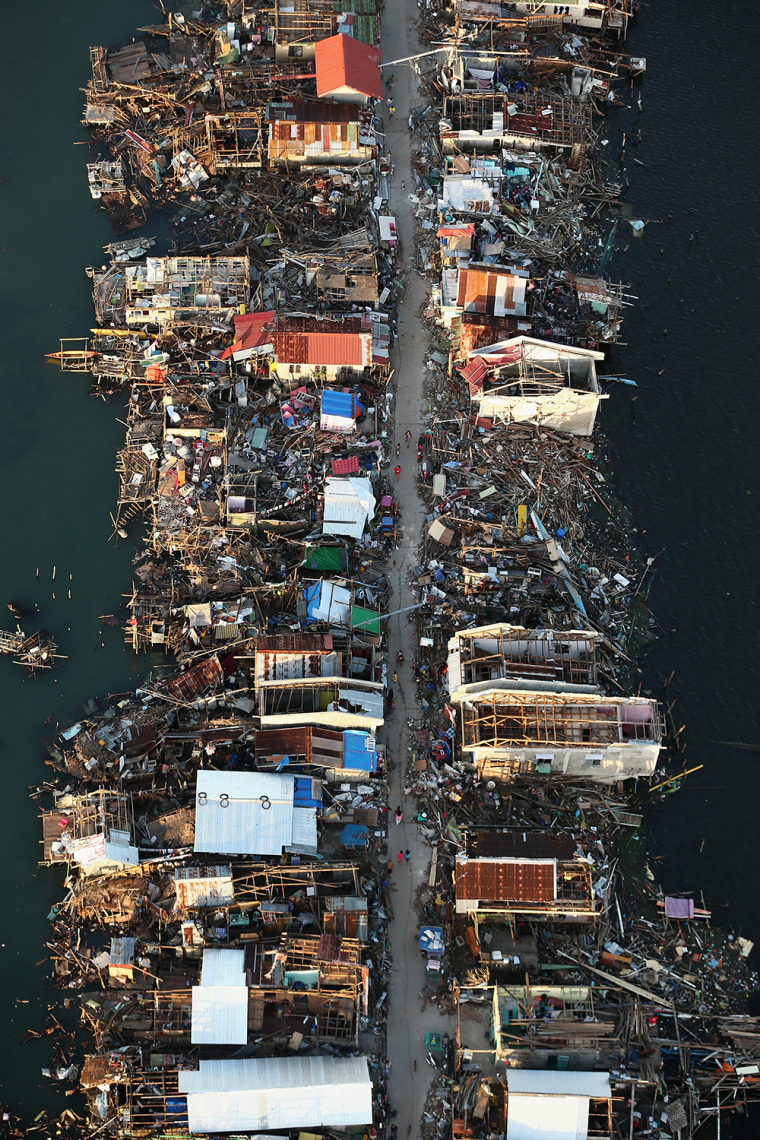
As the Philippines grapples with the devastating aftermath of Typhoon Haiyan, Filipinos are asking why the country wasn’t better prepared to deal with the super storm.
Government officials claim they were ready, broadcasting warnings of a potential 20-foot storm surge on the hour, starting two days before the typhoon hit.
Jerry Yaokasin, Tacloban's vice mayor, told Reuters that "some people just didn't believe us because it was so sunny. Some were even laughing." Many local men reportedly stayed in their homes to protect their belongings from looters.
"People were warned about the storm surge," said Toby Monsod, an economics professor at the University of the Philippines in Manila. "Though, many probably thought that it would be one meter high, not five. This storm was off the scales," she told NBC News.
Many are now blaming not just the reportedly 175 mph winds, but the flimsy construction of homes and buildings in the Philippines – and the years of government corruption which prevented the building of anything better.

Shacks instead of reinforced concrete
Antonio Lilles is a residential home builder in Manila who has spent the past week like most Filipinos – glued to his cellphone, accounting for family members and making sure friends and employees are safe.
He's also watched every video clip he could find on TV and YouTube of Super Typhoon Haiyan, one of the most devastating storms ever to hit land. Lilles says he was shocked to see Alfred Romualdez, the mayor of Tacloban – the worst-hit city within the disaster zone – telling the BBC that he and his family decided to ride out the storm in their sea-level beach house.
"What really angers me is that, if the mayor didn't think seriously about evacuating Tacloban himself, I assume he didn't ask his [220,000] people to evacuate either and seek higher ground," Lilles said. He noticed the rolling hills in the background of many of the apocalyptic images. "Why didn't people, especially car owners, drive up the slopes or away from the coast? It must mean they didn't know about the 15-foot tsunami heading their way, or just didn't care."
Even Monsod admitted that lessons need to be learned if the Philippines is to avoid – or at least limit – such devastating loss during future typhoons. "Historically, Filipinos adapt to the climate," she said. "They get through the storms and rebuild if they have to. But this is not sustainable in the long run."
Recalling the eerie Tacloban images of a few reinforced concrete structures jutting out from a morass of twisted metal and smashed plywood, she said: "We need to invest in technological solutions like low-cost housing with climate-proof materials. We've seen this in places like Guam."

Roberto Lilles, Antonio's older brother and a successful architect, agrees that much of the wreckage from dozens of typhoons that strike each year could be greatly reduced if low-cost, brick-and-mortar housing replaced the traditional flimsy wood and tin-roof homes.
"There is low-cost housing that can resist the storms. But most people in those rural areas are so poor, they still can't afford them," he explained.
But if private builders like the Lilles brothers find low-cost housing schemes unprofitable, why doesn't the Philippine government subsidize them?
In a word: corruption.
History of government corruption
President Benigno Aquino III, known as "Noynoy," the scion of two political families some compare to the Clinton or Bush dynasties, was elected in 2010, above all, to eradicate the endemic corruption that drains some $50 billion a year from state coffers.

He was seen as the only man for the job: his father, Senator Benigno Aquino Jr., was assassinated in a plot by alleged loyalists of then-dictator Ferdinand Marcos; his mother, Corazon Cojuangco Aquino, led the "People Power" revolt that toppled Marcos and became both the nation's first female president and a living symbol of democracy.
But Noynoy Aquino now finds himself implicated in his own "pork barrel" scam. While there's still no smoking gun, Aquino has been accused by association of using more than $500 million in public funds – including money meant for local infrastructure, like roads and bridges, in the very areas that took the brunt of Haiyan – to buy off key senators' loyalty. Last week there were nationally televised hearings on the scandal just as the storm was barreling toward the Philippines.
Aquino has strongly denied the accusations, but his approval rating has plummeted. And critics say the scandal has left him too distracted and on the defensive to deal with the nation’s perennial problems – poor urban planning, an exploding population, climate change and systemic poverty – all contributing factors to the death and destruction left in the super typhoon's wake.
For his part, Aquino stands by his record, telling CNN earlier this week that Haiyan's death toll would have been much higher without his government's evacuation of more than 750,000 people. "But, of course, nobody imagined the magnitude that this super typhoon brought on us," he said.
But it must be said that the roots of the Philippines' losing battle against infamously bad weather long predates this Aquino administration. Imelda Marcos, the larger-than-life former first lady who is notorious for her elaborate shoe collection, hails from Leyte province, ground zero for the storm surge.
But during some 20 years of the Marcos regime, while Leyte was blessed with a massive shrine (where Mrs. Marcos kept her shoes) and a big pink church, no one built low-cost housing or paved roads for the people.
Unnecessary disaster?
Antonio Lilles doesn't deny that Typhoon Haiyan – or Yolanda, as Filipinos call it – was a perfect storm.
"Can you imagine if those winds had hit Manila, with all the scaffolding and construction materials flying around from hundreds of sites?" he asked.
But he bristled at the unnecessary tragedy. "When I built my beach house I used the US NOAA (National Oceanic & Atmospheric Administration) storm surge guide for coastal buildings and built the house twice as high as the recommended 17 feet above sea level for storm surges. And then added two more feet for extra measure," he recalled. "It's just common sense and a little research."
For Toby Monsod, the economist, there's no better time than now to do better: "There's no question that Haiyan could have been much less disastrous."
Jim Maceda is an NBC News foreign correspondent who is currently based in London. He lived in Manila and covered Southeast Asia in the 1980's.
Related